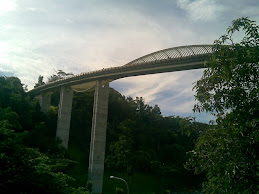By Adrian Lim, adrianl@sph.com.sg, Friday, 13 May 2016
Picture posted by Adrian Lim, adrianl@sph.com.sg, Friday, 13 May 2016
https://blogger.googleusercontent.com/img/b/R29vZ2xl/AVvXsEhK39QE5DF8Tpfg4PMwkmRfKo-hPbzFMjQ4eF4f1iuc6jzakmDyCkUxUH8WSmKPpeR7_JUiuAnizsSDCIMI414UYM8_wd4XyebAdP7v90T5JqyR_yHAWZqIGbPhheSkCRkwOLAE8KKJym4/s1600/st_20160513_allight13_2287982.jpg
http://www.straitstimes.com/sites/default/files/st_20160513_allight13_2287982.jpg
http://www.straitstimes.com/singapore/lightning-strikes-wont-hurt-mrt-commuters
The steel frame of an MRT train keeps commuters inside safe from lightning strikes, and is like the protection offered when one is inside a car or an aeroplane, said experts.
Hence, a lightning strike, which was suspected to have crippled an SMRT train during a heavy thunderstorm on Wednesday afternoon, would not be dangerous to passengers inside the train.
SMRT did not confirm if the train was hit and said only that lightning struck in a location between Yio Chu Kang and Khatib stations along the North-South Line. The affected train had to be pushed to a station by another, and no one was hurt.
Professor Liew Ah Choy from the National University of Singapore's electrical and computer engineering department said there is no significant voltage difference - which causes electrocution - in a metallic enclosure such as a train cabin when lightning strikes.
Prof Liew said the steel frame of the train rises in voltage during a strike, and the current would flow around the metallic walls of the train car. "In the process of doing so, because the wall is electrically conducting, there is very little voltage difference generated," he explained.
There is also no danger if a person is clutching a metallic pole in the cabin, he added. "Say, your hand is holding the pole and your feet are on the (train cabin) floor. The voltage on the pole is roughly the same as the voltage on the floor," he said.
In response to concerns raised by the public about lightning strikes on the MRT network, SMRT said in 2001 that the train cabin is, in scientific terms, a "Faraday cage" - a concept named after the 19th century scientist Michael Faraday.
Faraday cages often look like, well, a cage. They are built out of a conductive metal mesh that surrounds the sensitive electronics. This mesh of metal absorbs electromagnetic radiation that can be found throughout the universe and distributes it around the cage instead of letting it damage the components inside of it.
Posted by englandchronology.com on 1 August 2015
https://blogger.googleusercontent.com/img/b/R29vZ2xl/AVvXsEimDoUwPsDb-YcJgkh9Ud0wdYcBPAox_2QgPlvlAkzw5P1dW8RyxGQtUhxU2HVm8VRONNtUPkCpNdy2cdGDhZeR14BrQmXanL5dKvxLhUjR95vOfUv9FeuEBJ7OmbpUFukeHjyLoMl466E/s1600/bWFTS.png
http://i.stack.imgur.com/bWFTS.png
http://www.englandchronology.com/
Other examples of Faraday cages are cars and aeroplanes, where passengers are safe if lightning hits.
The transport operator said in a letter published in The New Paper in 2001: "A person may be electrocuted if there is a high electrical potential difference between two different parts of his body, causing electricity to flow through his body. There is no electrical potential difference inside a Faraday cage."
In Wednesday's case, the train's driver was said to have reported the incident, adding that he smelled something burning.
Asked about this phenomenon, a former SMRT train driver, who declined to be named, said there are electrical components in the train which may have been "shorted" by the sudden surge in voltage.
"The surge protectors may not be able to protect these parts, given that Wednesday's storm was quite severe.
There have been lightning strikes before, when the system tripped, but we were able to get the trains running soon after," he said.
The former employee said SMRT has over the years installed more lightning rods at viaducts in open areas as additional safety measures.
According to the National Environment Agency, Singapore has one of the highest occurences of lightning activity in the world.
Even so, lightning strikes on MRT trains are not common. The last case reported in the media was in September 2013, when a strike somewhere around Kranji station caused an electrical failure that held up North-South Line services for 35 minutes.
By Adrian Lim, adrianl@sph.com.sg, Friday, 13 May 2016
This article was first published on May 13, 2016.
Get a copy of The Straits Times or go to straitstimes.com for more stories.
Make sure you know when/how/where to seek cover.
Posted by NWSPueblo on July 2015
https://blogger.googleusercontent.com/img/b/R29vZ2xl/AVvXsEhBu2P1GPRwxNyMCWRfe8f8wJZ0s0_oj2t2hAFoTnZBhcTBHE98dfsoMJ_AIvFLPBs-vy20pdFYVN4LDf62G7EIgpkjv7QDAI2juguGQpGTgNGnoJHtKgM5BEmWT6LqYIb3-dwwTPLOB_A/s1600/CI1-UaGUAAEovbS.png
http://pbs.twimg.com/media/CI1-UaGUAAEovbS.png
http://www.scoopnest.com/user/NWSPueblo/616287612970479616
Reference
- https://blogger.googleusercontent.com/img/b/R29vZ2xl/AVvXsEhK39QE5DF8Tpfg4PMwkmRfKo-hPbzFMjQ4eF4f1iuc6jzakmDyCkUxUH8WSmKPpeR7_JUiuAnizsSDCIMI414UYM8_wd4XyebAdP7v90T5JqyR_yHAWZqIGbPhheSkCRkwOLAE8KKJym4/s1600/st_20160513_allight13_2287982.jpg
- http://www.straitstimes.com/sites/default/files/st_20160513_allight13_2287982.jpg
- http://www.straitstimes.com/singapore/lightning-strikes-wont-hurt-mrt-commuters
- https://blogger.googleusercontent.com/img/b/R29vZ2xl/AVvXsEimDoUwPsDb-YcJgkh9Ud0wdYcBPAox_2QgPlvlAkzw5P1dW8RyxGQtUhxU2HVm8VRONNtUPkCpNdy2cdGDhZeR14BrQmXanL5dKvxLhUjR95vOfUv9FeuEBJ7OmbpUFukeHjyLoMl466E/s1600/bWFTS.png
- http://i.stack.imgur.com/bWFTS.png
- http://www.englandchronology.com/
- https://blogger.googleusercontent.com/img/b/R29vZ2xl/AVvXsEhBu2P1GPRwxNyMCWRfe8f8wJZ0s0_oj2t2hAFoTnZBhcTBHE98dfsoMJ_AIvFLPBs-vy20pdFYVN4LDf62G7EIgpkjv7QDAI2juguGQpGTgNGnoJHtKgM5BEmWT6LqYIb3-dwwTPLOB_A/s1600/CI1-UaGUAAEovbS.png
- http://pbs.twimg.com/media/CI1-UaGUAAEovbS.png
- http://www.scoopnest.com/user/NWSPueblo/616287612970479616






































.jpg)
.gif)
.jpg)
























































